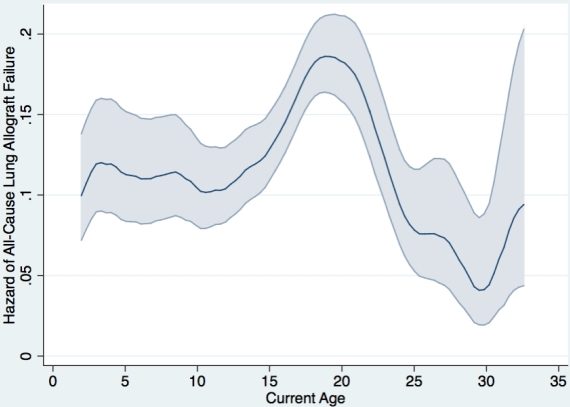High-Risk Age Window for Graft Loss in Pediatric Lung and Heart Transplant Recipients.
Johns Hopkins University, Baltimore.
Meeting: 2016 American Transplant Congress
Abstract number: 148
Keywords: Graft survival, Heart transplant patients, Lung transplantation, Pediatric
Session Information
Session Name: Concurrent Session: Lung Transplant: Moving the Field Forward
Session Type: Concurrent Session
Date: Sunday, June 12, 2016
Session Time: 4:30pm-6:00pm
 Presentation Time: 4:54pm-5:06pm
Presentation Time: 4:54pm-5:06pm
Location: Room 313
Late adolescence and early adulthood is a high-risk age window for pediatric kidney graft loss, though not for pediatric liver graft loss. It is unknown if this time period is a high-risk window for pediatric heart or lung transplant recipients. Such knowledge may inform the etiology of this high-risk window for transplant recipients (nonadherence/other social factors vs. biologic mechanism) and identify opportunities for intervention.
Using Scientific Registry of Transplant Recipients data, graft loss risk across current recipient age was compared between pediatric lung (n=1063) and heart (n=7827) transplants using piecewise-constant hazard rate models. The lung transplant model was adjusted for year, as well as donor (race, cause of death) and recipient (gender, race, FVC(%), functional status) characteristics. The heart transplant model was adjusted for year, as well as donor (gender, age, cause of death) and recipient (gender, race, bilirubin, weight, height) characteristics.
Lung graft loss during late adolescence and early adulthood (ages 17-24 years) was significantly greater than during ages <17 (aHR=1.32, 95%CI=1.11-1.58, p=0.002) and ages >24 (aHR=0.51, 95%CI=[thinsp]0.34-0.76, p=0.001)  . In contrast, the high-risk age window for heart graft loss was 0-3, compared to ages 3-17 (aHR=0.57, 95%CI=0.49-0.66; p<0.001), 17-24 (aHR=0.83; 95%CI=0.69-0.99; p=0.039), and >24 (aHR=0.57; 95%CI=0.45-0.72; p<0.001)
. In contrast, the high-risk age window for heart graft loss was 0-3, compared to ages 3-17 (aHR=0.57, 95%CI=0.49-0.66; p<0.001), 17-24 (aHR=0.83; 95%CI=0.69-0.99; p=0.039), and >24 (aHR=0.57; 95%CI=0.45-0.72; p<0.001)  .
.
Similar to the case of pediatric kidney transplant recipients, late adolescence and early adulthood is a high-risk period for pediatric lung transplant recipients, while that time period is not characterized by an increased risk of graft loss for pediatric liver and heart transplant recipients. These disparate findings suggest that sociobehavioral mechanisms alone do not fully account for the high-risk age window and that other biologic etiologies may be involved.
CITATION INFORMATION: Orandi B, Luo X, Van Arendonk K, Higgins R, Segev D. High-Risk Age Window for Graft Loss in Pediatric Lung and Heart Transplant Recipients. Am J Transplant. 2016;16 (suppl 3).
To cite this abstract in AMA style:
Orandi B, Luo X, Arendonk KVan, Higgins R, Segev D. High-Risk Age Window for Graft Loss in Pediatric Lung and Heart Transplant Recipients. [abstract]. Am J Transplant. 2016; 16 (suppl 3). https://atcmeetingabstracts.com/abstract/high-risk-age-window-for-graft-loss-in-pediatric-lung-and-heart-transplant-recipients/. Accessed December 29, 2025.« Back to 2016 American Transplant Congress
